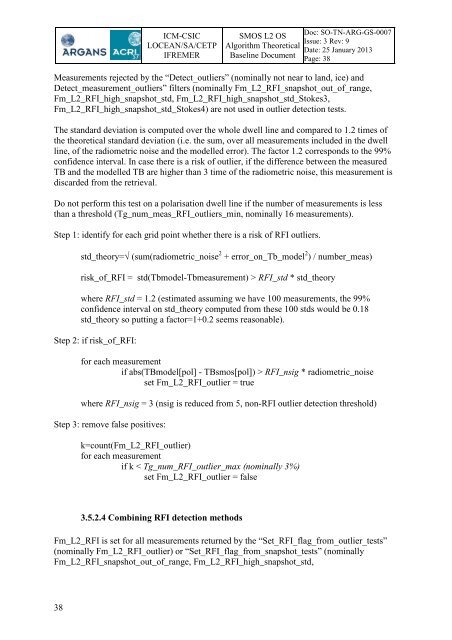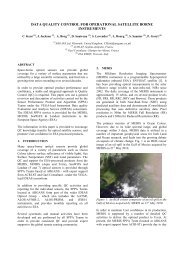SMOS L2 OS ATBD - ARGANS
SMOS L2 OS ATBD - ARGANS
SMOS L2 OS ATBD - ARGANS
Create successful ePaper yourself
Turn your PDF publications into a flip-book with our unique Google optimized e-Paper software.
38<br />
ICM-CSIC<br />
LOCEAN/SA/CETP<br />
IFREMER<br />
<strong>SM<strong>OS</strong></strong> <strong>L2</strong> <strong>OS</strong><br />
Algorithm Theoretical<br />
Baseline Document<br />
Doc: SO-TN-ARG-GS-0007<br />
Issue: 3 Rev: 9<br />
Date: 25 January 2013<br />
Page: 38<br />
Measurements rejected by the “Detect_outliers” (nominally not near to land, ice) and<br />
Detect_measurement_outliers” filters (nominally Fm_<strong>L2</strong>_RFI_snapshot_out_of_range,<br />
Fm_<strong>L2</strong>_RFI_high_snapshot_std, Fm_<strong>L2</strong>_RFI_high_snapshot_std_Stokes3,<br />
Fm_<strong>L2</strong>_RFI_high_snapshot_std_Stokes4) are not used in outlier detection tests.<br />
The standard deviation is computed over the whole dwell line and compared to 1.2 times of<br />
the theoretical standard deviation (i.e. the sum, over all measurements included in the dwell<br />
line, of the radiometric noise and the modelled error). The factor 1.2 corresponds to the 99%<br />
confidence interval. In case there is a risk of outlier, if the difference between the measured<br />
TB and the modelled TB are higher than 3 time of the radiometric noise, this measurement is<br />
discarded from the retrieval.<br />
Do not perform this test on a polarisation dwell line if the number of measurements is less<br />
than a threshold (Tg_num_meas_RFI_outliers_min, nominally 16 measurements).<br />
Step 1: identify for each grid point whether there is a risk of RFI outliers.<br />
std_theory= (sum(radiometric_noise 2 + error_on_Tb_model 2 ) / number_meas)<br />
risk_of_RFI = std(Tbmodel-Tbmeasurement) > RFI_std * std_theory<br />
where RFI_std = 1.2 (estimated assuming we have 100 measurements, the 99%<br />
confidence interval on std_theory computed from these 100 stds would be 0.18<br />
std_theory so putting a factor=1+0.2 seems reasonable).<br />
Step 2: if risk_of_RFI:<br />
for each measurement<br />
if abs(TBmodel[pol] - TBsmos[pol]) > RFI_nsig * radiometric_noise<br />
set Fm_<strong>L2</strong>_RFI_outlier = true<br />
where RFI_nsig = 3 (nsig is reduced from 5, non-RFI outlier detection threshold)<br />
Step 3: remove false positives:<br />
k=count(Fm_<strong>L2</strong>_RFI_outlier)<br />
for each measurement<br />
if k < Tg_num_RFI_outlier_max (nominally 3%)<br />
set Fm_<strong>L2</strong>_RFI_outlier = false<br />
3.5.2.4 Combining RFI detection methods<br />
Fm_<strong>L2</strong>_RFI is set for all measurements returned by the “Set_RFI_flag_from_outlier_tests”<br />
(nominally Fm_<strong>L2</strong>_RFI_outlier) or “Set_RFI_flag_from_snapshot_tests” (nominally<br />
Fm_<strong>L2</strong>_RFI_snapshot_out_of_range, Fm_<strong>L2</strong>_RFI_high_snapshot_std,



